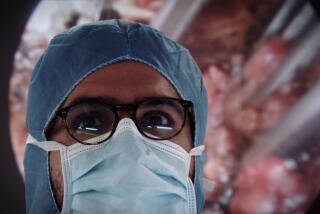Doctor Seeks to Develop Robot to Perform Surgery
- Share via
MEMPHIS, Tenn. — A robot surgeon that mimics and “downsizes” human movements could be more precise than the doctors guiding it, says a surgeon who hopes one day to perform the most delicate eye operations by remote control.
Dr. Steve Charles, who has been working on his robot for about a year, expects in another year to have equipment ready for testing on dummy eyes in the operating room. Charles, 46, says he has spent about $300,000 so far.
‘Mimics His Motions’
“Nobody else now is working on robotics operated by a human being where it mimics his motions but downsizes them,” he said.
Charles’ system, which uses three groups of machines and supporting computers, would allow a doctor to view his patient’s eye on a TV screen while performing surgical movements with tools similar in concept to joysticks used for video games. Small mechanical arms would actually perform the surgery.
“One (group) would be analogous to a person’s head and eye muscles that positions the microscope,” he said. “The other two robots position the surgical tools to work on a dummy head with dummy eyes in it.”
Charles, an engineering student in undergraduate school, specializes in microsurgery that can require removal of tiny scars from a patient’s retina. He said the equipment could be adapted to other delicate surgery as well.
“Robots that are manually operated now are for things like fixing up nuclear reactors, picking up submarine parts at the bottom of the ocean or black boxes after airplane crashes, the hazardous-environment stuff,” Charles said. “They’re like great big gorillas. Now, we’ll have a guy that is more precise than the most precise watchmaker or surgeon ever was.”
Long-Distance Surgery
He hopes that his robot will also let a surgeon operate on a patient hundreds or thousands of miles away--in remote areas or on a space station, for example. A medical team would be required on the scene to set up the equipment and monitor the patient, but the surgeon could be elsewhere.
Charles has set up the Center for Engineering Applications to pursue his robot project and signed up Roy Williams, an electrical engineer, to handle the day-to-day lab work. The project has attracted assistance from engineers and physicians across the country, including specialists with the National Aeronautics and Space Administration and the Air Force, he said.
Charles, a member of the surgical staff at Baptist Hospital here, received a $300,000 grant from the Baptist Memorial Health Care Foundation and is looking for further assistance from government grants or foundations.
“It’s the kind of thing that will never get finished,” he said. “It will be evolving with better performance every year. We anticipate a budget that ultimately will approach the range of $3 million to $4 million a year.
“This is public-domain stuff. This is not an entrepreneurial effort on my part.”
Much of the progress on developing the equipment will depend on continued advances in small-motor technology and related fields, he said. Specialists in those areas say research on small-motor technology is a growth industry.
More to Read
Sign up for Essential California
The most important California stories and recommendations in your inbox every morning.
You may occasionally receive promotional content from the Los Angeles Times.












